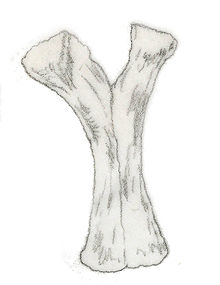Euskelosaurus
| Euskelosaurus | |
|---|---|

| |
| E. browni ischia | |
| Scientific classification | |
| Domain: | Eukaryota |
| Kingdom: | Animalia |
| Phylum: | Chordata |
| Clade: | Dinosauria |
| Clade: | Saurischia |
| Clade: | †Sauropodomorpha |
| Family: | †Plateosauridae |
| Genus: | †Euskelosaurus |
| Species: | †E. browni
|
| Binomial name | |
| †Euskelosaurus browni | |
Euskelosaurus ("good leg lizard") is a sauropodomorph dinosaur from the Late Triassic of South Africa and Lesotho. Fossils have only been recovered from the lower Elliot Formation in South Africa and Lesotho,[1] and in one locality in Zimbabwe.[2]
History of discovery
In 1863, Alfred Brown recovered fossil material consisting of limb bones and vertebrae, in the lower Elliot Formation in the southeastern Free State. In 1866, Thomas Henry Huxley first described Euskelosaurus from Brown's fossil material, and named the holotype specimen Euskelosaurus brownii after Brown.[3] Harry Seeley later described Euskelosaurus in 1894,[4] as did Friedrich von Huene in 1902. Since then, other researchers, including Robert Broom, have mentioned Euskelosaurus in their papers,[5][6][7][8][9] although later papers refer to the material under the name Plateosauravus.[10][11][12]
Description
Euskelosaurus is considered to have been a large, robust member of the sauropodomorph clade. Estimates from the existing fossil material measure this dinosaur at about 12.2 m (40 ft) in length and 7 t (7.7 short tons) in weight.[13] With such parameters it was the largest of the non-sauropod ("prosauropod") sauropodomorphs.[13] Its bones are robust and it had a graviportal limb arrangement, a key character trait of basal sauropodomorphs.[14][15][16]
Classification
While paleontologists generally consider Euskelosaurus a basal plateosaurid sauropodomorph, it has recently been considered a nomen dubium and a “waste-basket” taxon with poorly understood phylogenetic relationships, warranting further study.[17]
References
- ^ Gauffre, Francois-Xavier (1993). "Biochronostratigraphy of the Lower Elliot Formation, southern Africa) and preliminary results on the Maphutseng dinosaur. Saurischia: Prosauropoda) from the same Formation of Lesotho". In Lucas, Spencer G.; Morales, Michael (eds.). The Nonmarine Triassic: Bulletin 3. pp. 147–9.
- ^ Cooper, M.R. (1980). "The first record of the prosauropod dinosaur Euskelosaurus from Zimbabwe". Arnoldia Zimbabwe. 9 (3): 1–17.
- S2CID 248534963.
- .
- ^ Broom, R. (1911). "On the dinosaurs of the Stormberg, South Africa". Annals of the South African Museum. 7: 291–308.
- OCLC 10876430.[page needed]
- .
- ISBN 978-0-620-32470-0.
- .
- ^ Yates, A.M. (2003). A new species of the primitive dinosaur Thecodontosaurus (Saurischia: Sauropodomorpha) and its implications for the systematics of early dinosaurs. Journal of Systematic Palaeontology 1(1):1-42
- ^ Yates, A.M., and Kitching, J.W. (2003). The earliest known sauropod dinosaur and the first steps towards sauropod locomotion. Proceedings of the Royal Society of London B 270(1525):1753-1758.
- Aliwalia rexGalton. Historical Biology, iFirst article, 1-30.
- ^ ISBN 9780486838557. Retrieved 2022-08-25.)
{{cite book}}: CS1 maint: multiple names: authors list (link - .
- hdl:10539/21644.
- .
- ^ Krupandan, Emil Darius (2019). "Unravelling the biology of the Southern African Sauropodomorph dinosaurs, Plateosauravus and the 'Maphutseng dinosaur'".
{{cite journal}}: Cite journal requires|journal=(help)
